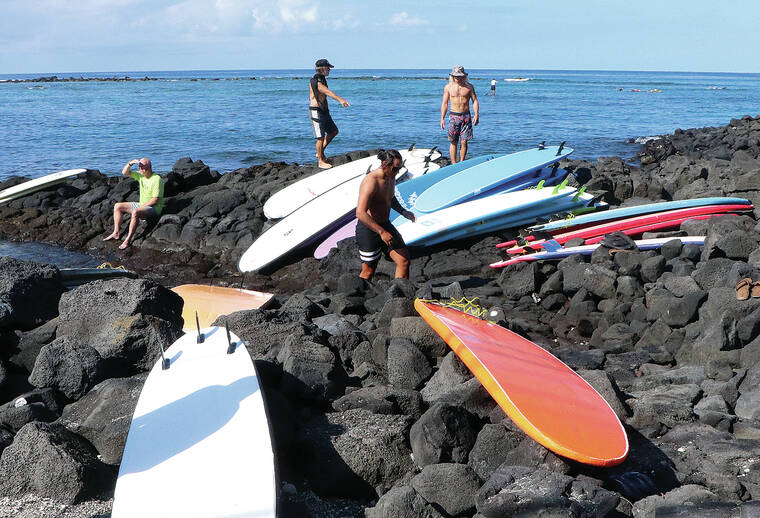Kahalu‘u surf school rules approved

The state Land Board voted unanimously Friday to approve rules that limit and regulate commercial surf school activity in Kahalu‘u Bay. (Courtesy of DLNR/Special to West Hawaii Today)
The state Land Board voted unanimously Friday to approve rules that limit and regulate commercial surf school activity in Kahalu‘u Bay.
The state Land Board voted unanimously Friday to approve rules that limit and regulate commercial surf school activity in Kahalu‘u Bay.
“This regulation, it’s definitely a step forward in making this a safer environment for all of our park users,” Hawaii County Department of Parks and Recreation Director Maurice Messina told the land board before its 7-0 vote. Hawaii County manages Kahalu‘u Beach Park but doesn’t have permitting authority over the bay’s waters.
Under the rules, which still need Gov. David Ige’s signature to become final, the Department of Land and Natural Resources Division of Boating and Ocean Recreation will be authorized to issue up to eight permits for commercial surf school instruction, an increase from the current four permitted by rules established in 2016 at the popular North Kona site.
Though there would be more companies permitted to operate in the bay overall, t he rules would create two instruction periods for the bay, spreading out the impact. Four commercial surf schools would be permitted to operate from 8 a.m. to noon and the other four from 1-5 p.m. The number of students allowed in the water was reduced to four per operator, for a total of 16 at any given time.
During a virtual public assessment hearing on Sept. 8, the Department of Land and Natural Resources said 21 people provided verbal testimony; another 48 mailed or emailed testimony.
The Division of Boating and Ocean Recreation (DOBOR) submittal to the Board of Land and Natural Resources (BLNR) characterized testifiers as being opposed into two groups: Those who opposed all commercial activity at Kahalu‘u Bay, and, second, those who opposed commercial operation shifts, whom were largely commercial operators.
“DOBOR’s primary concerns are for the safety of ocean users and protection of the natural resources,” the background report submitted to the board reads. “Therefore, DOBOR’s recommendations focus on the area’s capacity for commercial use.”
Messina on Friday highlighted for the board a handful of safety concerns at the bay, which he said he visited the day before the virtual meeting. On that Thursday, he said he counted 10 to 15 different surf school trucks and vans and people walking back and forth across busy Alii Drive with surfboards. He described the bay “as pretty dangerous” with surf schools giving instruction and “regular folks” on paddleboards all seeking one of the few small waves rolling into the bay.
Police are also having trouble regulating parking along the roadway, he said. He also indicated there have been “issues” between the surf schools vying for waves to sustain their businesses.
“We hear of these guys cutting each other’s tires and vandalizing each other’s equipment because there’s just so many of them out there at the same time competing for the same wave,” Messina said.
DOBOR did submit a change to the rules that went to public hearing in September to clarify that they apply to all non-motorized craft, such as stand-up paddleboards and e-foils, not only surfboards, in Zone A, or the northern side of Kahalu‘u Bay.
After some discussion by the board over concerns about the alteration being a “substantive change” that would require another public hearing, and reassurance from a state deputy Attorney General, it would not need another hearing, the board voted to pass the rule as presented Friday.
Another possible change will have to be taken to public hearing, because it would, in fact, be considered a “substantive change,” said Ed Underwood, administrator of DOBOR.
“During conversations at the public hearing, it was brought up that, maybe, we should close all commercial activity or prohibit all commercial activity on weekends or Sundays, one day of the week,” he told the board. “That’s something we can look at, but it wasn’t a part of the rule amendment package so that would be considered a ‘substantive change.’ We figured we could do that at a later date, if that’s something we want to do in the future.”
The DLNR, Hawaii County and other stakeholders have been discussing since at least 2015 the issue of regulating commercial surf instruction at Kahalu‘u Bay, though the issue comes up in West Hawaii Today archives as early as 2004-05.
Initially, Hawaii County was to take the lead in limiting access to Kahalu‘u Bay ocean waters and enforcing those limitations, however, after learning it was not the permitting authority no permits were issued.
The state took the lead on permitting commercial surf schools at Kahalu‘u Bay in 2019 after an agreement was reached after state and county officials met in June 2019 at the request of the state Legislature.
The Attorney General will next review the rules approved by the BLNR Friday they can be transmitted to the governor for his signature and filing with the lieutenant governor. At that point, the rules have the effect of law.
The permits would be issued via lottery, DOBOR staff said during an earlier BLNR meeting.


